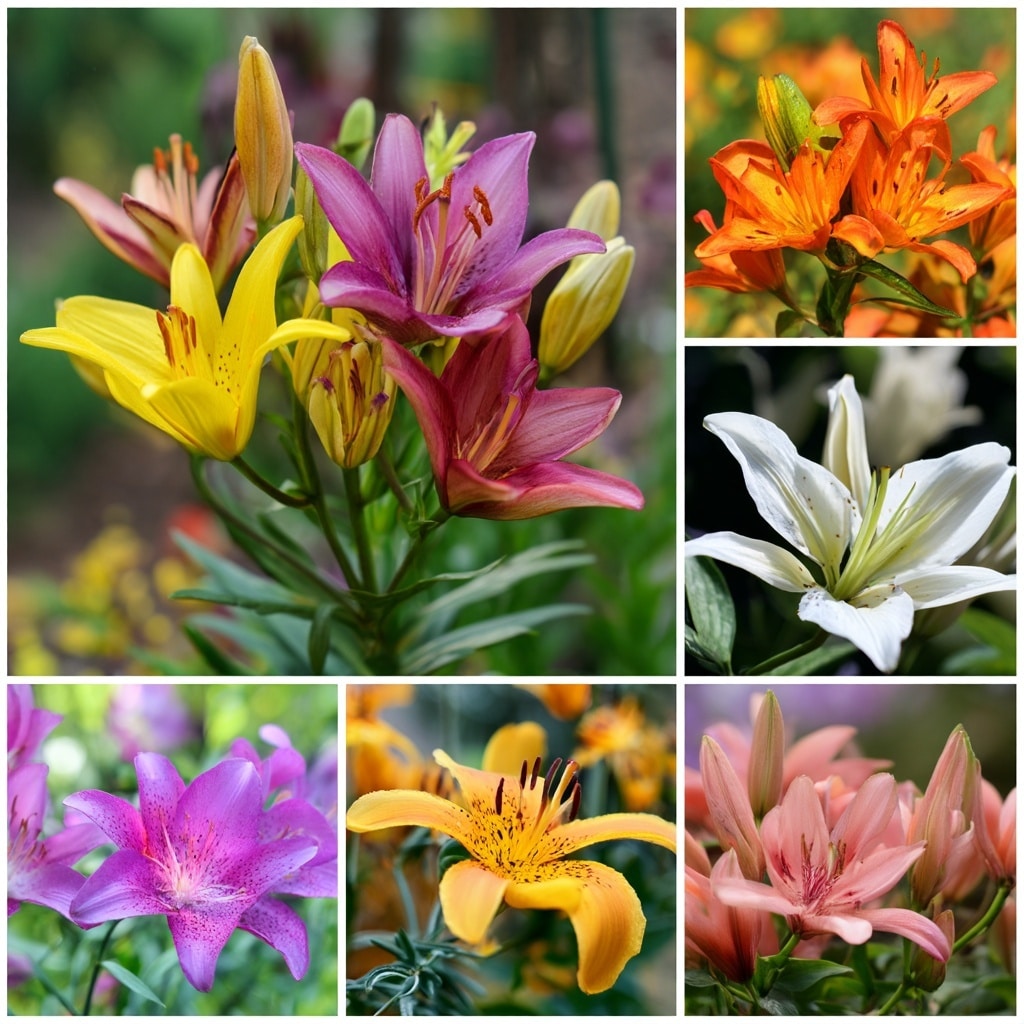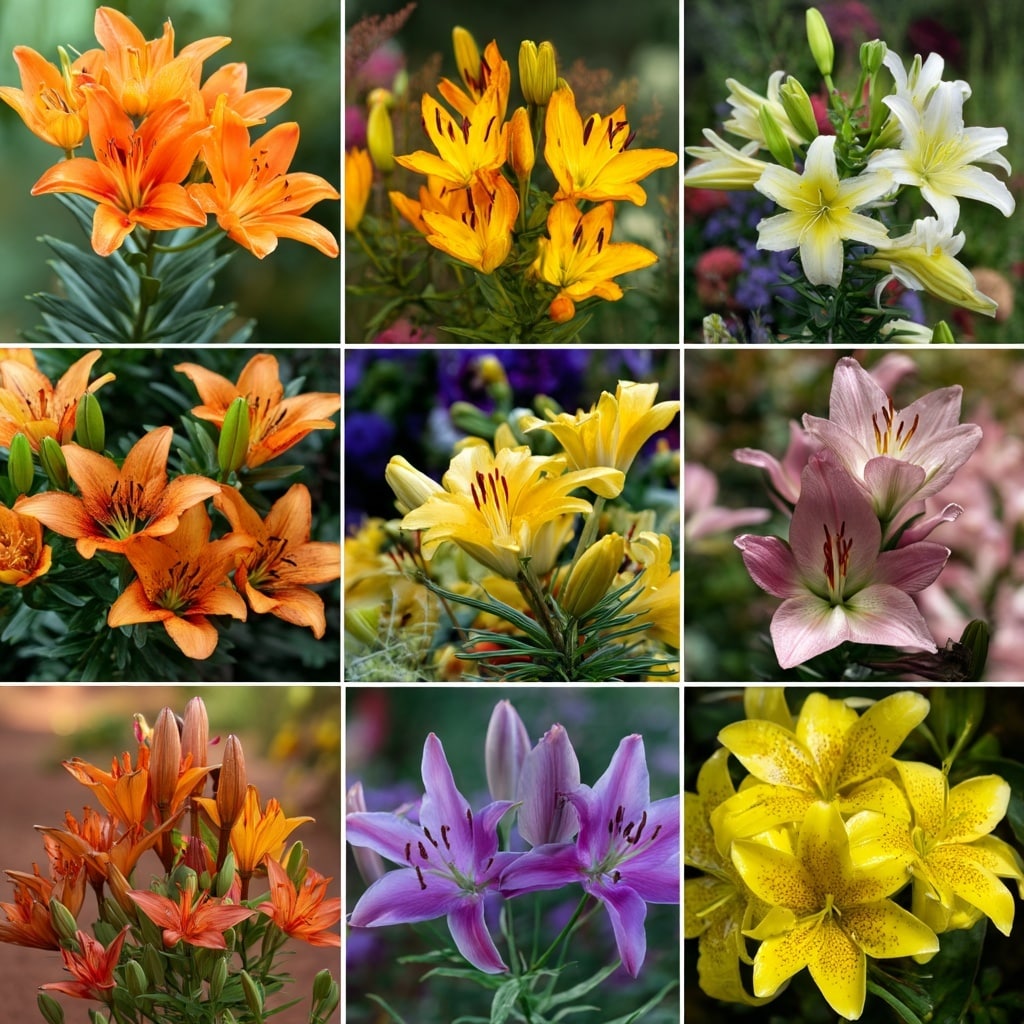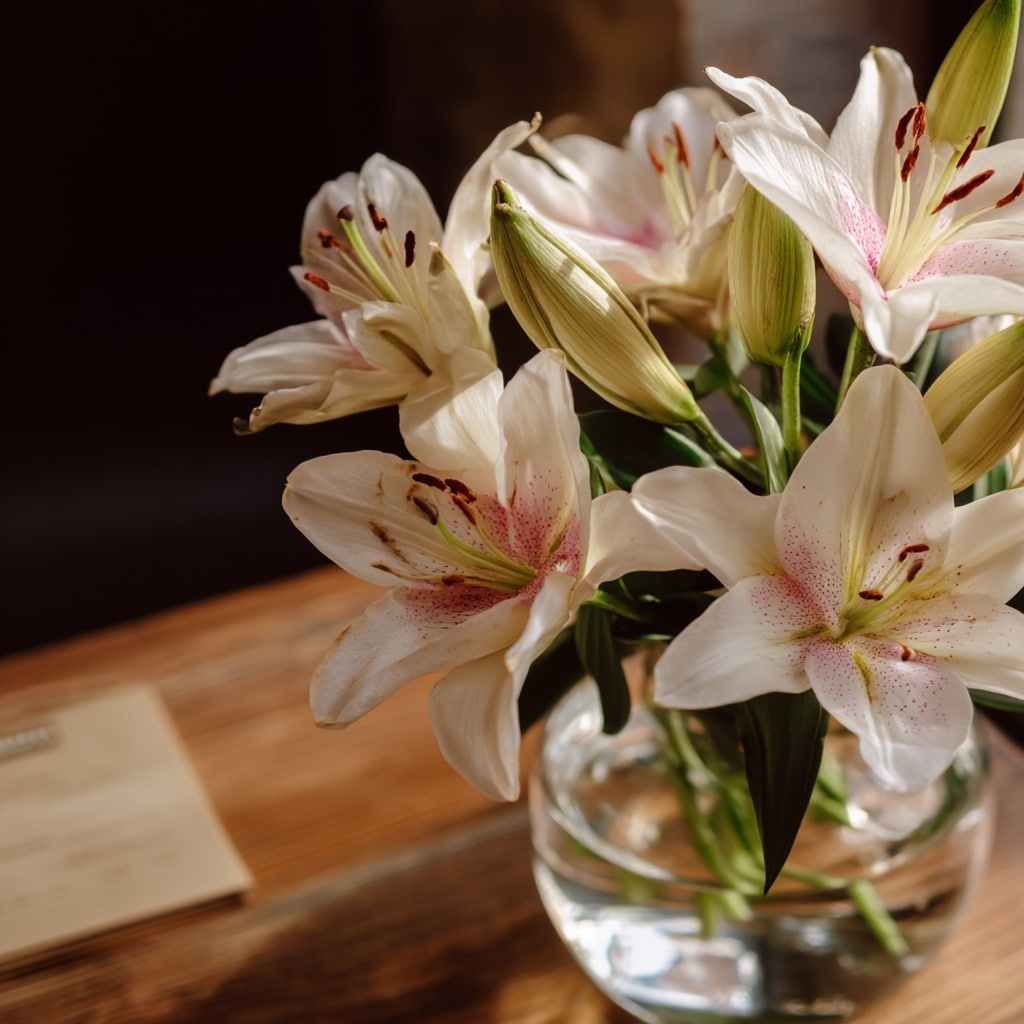Flower lily is a term that evokes elegance, fragrance, and timeless beauty. With its majestic petals and rich symbolism, the flower lily is one of the most cherished blooms in both gardens and floral arrangements worldwide. From pure white to vibrant pinks and bold oranges, this perennial flower is a standout in every season it blooms. But beyond its striking looks, the flower lily offers a story of heritage, care, and variety that deserves attention—whether you’re arranging a bouquet or planting a summer showstopper in your backyard.
How to Care for Cut Flower Lilies
Bringing the flower lily into your home is like adding a touch of art to your everyday space. Whether you’ve picked up a bouquet from the market or received a thoughtful gift, knowing how to extend the vase life of your flower lilies makes all the difference. Here are easy, practical steps to keep them fresh and stunning:
Tips for Longer Vase Life
- Choose tight buds: When buying lilies, select ones with buds that haven’t fully opened yet. This means they’ll bloom gradually and last longer.
- Trim smartly: Use a sharp, clean knife or pruners to cut the stems at a diagonal. This increases the surface area for water uptake.
- Strip the lower leaves: Any leaves that might sit below the waterline should be removed to prevent bacteria and mold.
- Feed your flowers: Always add flower food to the water. It provides nutrients and helps keep the water clean.
- Use lukewarm water: Flower lilies prefer slightly warm water to get started in a vase.
- Watch their placement: Avoid placing your vase near heaters, direct sun, or in drafts. These conditions shorten bloom time.
- Keep them away from fruit: Ripening fruit releases ethylene gas, which causes flower lilies to wilt faster.
- Refresh the water often: Change the water every couple of days to prevent cloudiness and odor.
- Cut the stamens (optional): If you’re worried about pollen stains or find the scent overpowering, you can snip off the stamens. Just be careful not to damage the petals.
- Pollen on clothes? Gently dab the stain with sticky tape—never rub, as this pushes it deeper into the fabric.
With the right care, a flower lily in a vase can brighten your room for 10 days or more.
Flower Lily Characteristics

The flower lily (genus Lilium) is more than just a pretty bloom—it’s a botanical masterpiece with layers of charm. Known for its trumpet-shaped flowers and rich palette of colors, this perennial is as diverse as it is dazzling. Each flower lily bloom typically features six large, petal-like tepals, often with elegant curves, speckles, or frilled edges.
Color & Shape Variety
You’ll find flower lilies in a rainbow of hues: pure white, soft pinks, fiery reds, golden yellows, regal purples, and even orange shades. Some varieties offer intricate details like spots, stripes, or subtle gradients that make each bloom feel unique.
They can vary greatly in shape too:
- Trumpet-shaped blooms
- Bowl-like or flat-faced forms
- Flowers ranging from 7 to 25 cm wide
Fragrance & Scent
Scent is another hallmark of the flower lily. While some varieties are lightly perfumed or entirely scentless, others (like Oriental lilies) are deeply fragrant—a single stem can fill a room.
Growth Habit
- Perennial plant with non-woody stems
- Grows from bulbs, not seeds
- Typically dies back in winter and regrows each spring
A mature flower lily can reach heights between 60 cm and 1.5 meters, depending on the variety. Its upright stature and showy blooms make it a favorite in both garden borders and balcony pots.
Family Ties
The flower lily belongs to the Liliaceae family, which includes other popular bulb flowers such as tulips, hyacinths, and snowdrops. But unlike many of its relatives, the lily boasts a longer bloom time and more prominent symbolism.
Blooming Season
Most flower lilies bloom from June to September, making them a staple of summer gardens. Their tall stems and vibrant petals bring vertical drama and lasting color when many other perennials are starting to fade.
Types of Flower Lily

One of the most captivating things about the flower lily is how diverse it is. With over 100 species and countless hybrids, there’s a type of flower lily for nearly every garden, bouquet, and personal style. Each variety has its own unique blend of color, shape, size, fragrance, and bloom time.
Here’s a guide to the most beloved types of flower lilies:
🧡 Asiatic Lilies
- Best for beginners – low-maintenance and hardy.
- Upright blooms in vibrant colors: red, orange, yellow, and pink.
- Little to no fragrance, ideal for those sensitive to scents.
- Petals are smooth-edged and sleek.
- Bloom time: late spring to early summer.
- Height: 60–100 cm.
🐯 Tiger Lilies
- A striking subtype of Asiatic lilies.
- Notable for speckled, downward-facing petals.
- Colors often include bold oranges and reds with dark spots.
- Very resilient and eye-catching in summer gardens.
- Bloom time: mid to late summer.
🌸 Oriental Lilies
- Famous for large, fragrant blooms with wavy petals.
- Colors range from white and pink to deep purples.
- Often associated with elegance and luxury.
- Taller plants (1–1.5 meters) may need staking.
- Bloom time: late summer (August–September).
🤍 Madonna Lily (Lilium candidum)
- Pure white, trumpet-shaped flowers with a heavenly scent.
- One of the oldest cultivated types of flower lily.
- Symbolizes purity and often linked to religious iconography.
- Blooms early and thrives in traditional gardens.
🎺 Longiflorum Lilies (Trumpet Lilies)
- Known for slender, trumpet-like flowers and rich fragrance.
- Ideal for bouquets and formal arrangements.
- Typically bloom from June to August.
- Height: 90 cm to 1.5 meters.
🌀 Martagon Lilies (Turkish Lilies)
- Distinctive curled-back petals that hang downward.
- Often speckled and appear in shades of red, yellow, purple, or white.
- Bloom early (June–July) and prefer partial shade.
- Great for naturalized or woodland-style gardens.
🧬 Hybrid Lilies
Many breeders have developed hybrids that combine the best traits of multiple species:
- LA Hybrids: Cross between Longiflorum and Asiatic—scented, colorful, and hardy.
- OT Hybrids: Oriental and Trumpet cross—tall, fragrant, and luxurious.
- American Hybrids: Bold colors and strong stems, perfect for large-scale planting.
🚫 Common Flower Lily Impersonators
Not all flowers with “lily” in their name are true lilies! Here are a few that don’t belong to the Lilium genus:
- Peace Lily (Spathiphyllum)
- Calla Lily (Zantedeschia)
- Day Lily (Hemerocallis)
- Lily of the Valley (Convallaria majalis)
While beautiful in their own right, these plants differ in structure, care, and classification.
How to Grow and Care for Flower Lily Outdoors

Planting a flower lily in your garden or on your balcony adds vertical drama and vibrant color to your outdoor space. With just a bit of planning and the right care, these bulbs will reward you year after year with spectacular blooms.
🛠️ Planting Tips
- When to plant: Spring or autumn is ideal. Plant bulbs as soon as possible after purchasing.
- Planting depth: Place bulbs about 10–15 cm deep.
- Spacing: Leave 20–40 cm between bulbs to allow for airflow and growth.
- Bulb orientation: Always plant with the pointed side facing up.
- Bigger bulbs = bigger blooms: Choose large, firm bulbs for the most impressive flowers.
☀️ Light & Location
- Flower lilies love sunshine—aim for at least 6 hours of direct sunlight daily.
- The ideal setup? Sun on top, shade at the base. You can mimic this by planting lilies among groundcovers or placing mulch (like bark) around the base to keep roots cool.
🌿 Soil & Drainage
- Lilies need well-draining soil to avoid bulb rot.
- If your garden soil is heavy or clay-like, consider adding sand or planting in raised beds or containers.
🌸 Watering & Feeding
- Keep soil evenly moist, but not soggy.
- In spring, apply a balanced organic fertilizer to support strong growth.
- Potted lilies need regular feeding throughout the growing season.
🌾 Support & Protection
- Tall varieties may need support—use garden stakes or cages to keep stems upright.
- In windy areas, plant near fences or hedges for added protection.
❄️ Seasonal Maintenance
After flowering:
- Remove spent blooms to prevent seed development and redirect energy to the bulb.
- Once stems yellow and dry out, cut them back to just above the soil.
- Leave the base foliage intact—it naturally dies off and nourishes the bulb.
Winter care:
- Lilies are hardy, but in colder regions, add a layer of mulch or bark chips in late autumn to insulate the bulbs.
Replanting tip: Every 4–5 years, dig up and relocate bulbs to a new spot to avoid overcrowding and refresh soil conditions.
With proper care, a flower lily will thrive for many seasons, becoming a true garden showpiece.
The Symbolism of the Flower Lily

The flower lily is more than just a beautiful bloom—it carries centuries of meaning, myth, and emotion. Across different cultures and traditions, the flower lily has become a powerful symbol of purity, femininity, transformation, and love.
🌺 Cultural Meanings
- Purity & Innocence: In many traditions, especially in Christianity, the white flower lily symbolizes virginity and purity. This is why it’s often used in weddings and religious ceremonies.
- Femininity: The ancient Greeks and Romans associated the flower lily with the goddess Hera and fertility. Brides wore crowns of lilies to symbolize hope for a fruitful life.
- Love & Romance: In Victorian times, gifting a sweet-smelling flower lily was a sign of true affection. Even today, lilies often appear in romantic bouquets.
- Grief & Impermanence: Because of its serene appearance, the flower lily is commonly included in funeral arrangements, symbolizing peace, renewal, and the transient nature of life.
🎨 Lily Color Meanings
Each flower lily color adds a layer of meaning, making color choice important in bouquets and garden design:
- White Lily: Symbolizes purity, virtue, rebirth, and is most often seen in weddings and memorials.
- Red Lily: Represents passion, deep love, and emotional strength.
- Orange Lily: Stands for confidence, pride, and wealth.
- Pink Lily: Associated with prosperity, femininity, and compassion.
- Yellow Lily: Evokes joy, cheerfulness, and gratitude.
- Purple Lily: Symbolizes spirituality, dignity, and royalty.
Including specific lily colors in your garden or floral arrangements allows you to tell a deeper story through flowers—whether you’re expressing joy, remembrance, or love.
Origins and Myths of the Flower Lily

The flower lily has a long and legendary past—one that stretches across continents, cultures, and centuries. It’s not just a plant; it’s a symbol rooted in mythology, religion, and art, with stories as rich as its vibrant blooms.
🌍 A Global Native
The wild ancestors of today’s flower lily can be found across Asia, Europe, and North America. Native to regions like:
- Japan and Korea
- The Balkans and the Alps
- Parts of the United States and Canada
Historians have traced the cultivation of the flower lily back over 3,000 years, with ancient references appearing in Egyptian, Chinese, and Greek texts. In medieval Europe, lilies were prized in monastery gardens, and by the Renaissance, they had become favorites in noble estates and palace grounds.
🧙♀️ Legends & Mythology
One of the most famous myths comes from Greek mythology, where the flower lily is linked to Hera, the queen of the gods. According to legend:
- Hera spilled a few drops of breast milk onto the earth, and lilies sprouted where it fell.
- This divine origin gave the flower lily its association with purity and feminine divinity.
In Christianity, the white lily—especially the Madonna lily—is closely associated with the Virgin Mary, often appearing in religious paintings and sculptures as a symbol of virtue and holiness.
🔄 A Symbol Through the Ages
- Romans and Greeks: Gave brides lily crowns for fertility.
- Medieval Europe: Cultivated in church gardens as sacred flowers.
- Victorian Era: Used flower lilies in coded floral language (“floriography”) to express deep emotions.
- Modern Day: Still a global favorite for weddings, memorials, and decorative gardens.
The name “lily” itself comes from the Latin word “lilium”, which stems from the Greek “leirion,” used in ancient times to describe a flower known for its beauty and purity.
The long journey of the flower lily—from myth to modern garden—adds a layer of meaning to every bloom.
Are Flower Lilies Toxic?

As breathtaking as the flower lily is, it’s important to know that beauty can come with a warning label—especially for households with pets or young children.
🚫 Toxic to Pets and People
All parts of the flower lily—including the stems, petals, leaves, pollen, and even the vase water—are toxic if ingested. The danger is particularly serious for cats:
- Cats: Extremely sensitive to lilies. Even brushing against the pollen and later grooming themselves can lead to acute kidney failure.
- Dogs: Less vulnerable than cats, but still at risk for gastrointestinal distress if they chew or ingest lily parts.
- Humans (especially children): Ingesting any part of the flower lily may cause nausea, vomiting, skin irritation, or diarrhea.
If ingestion occurs, immediate action is critical. Contact a vet or poison control center right away if a pet or child comes into contact with a flower lily.
🌼 Safer Alternatives
Love the look of lilies but need a pet-safe option? Consider:
- Double-flowered lilies like the Roselily — they often have reduced pollen and a lighter scent.
- Silk or faux lilies for indoor décor.
- Or avoid lilies altogether in homes with cats—many veterinarians recommend this as the safest route.
🧽 Safe Vase Practices
If you bring cut flower lilies into your home:
- Place vases out of reach of pets and children.
- Change the water often and dispose of it responsibly—don’t pour it into pet-accessible areas.
- Remove fallen petals and wipe up pollen with a damp cloth to avoid residue.
While the flower lily is a garden favorite and a popular gift flower, it’s essential to handle it responsibly to ensure everyone—furry friends included—stays safe.
Conclusion
The flower lily is more than just a garden staple—it’s a plant that tells a story of beauty, meaning, and resilience. Whether you’re growing it in your backyard or placing it in a vase, understanding its care, symbolism, and varieties helps you get the most from this iconic bloom. With the right location, soil, and attention, your flower lilies will return year after year, bringing color, height, and elegance to your outdoor or indoor space.
Just remember: while they’re stunning, flower lilies are toxic, so take precautions if you share your home with pets or small children. With care and respect, the flower lily remains one of the most rewarding plants to grow and enjoy.




